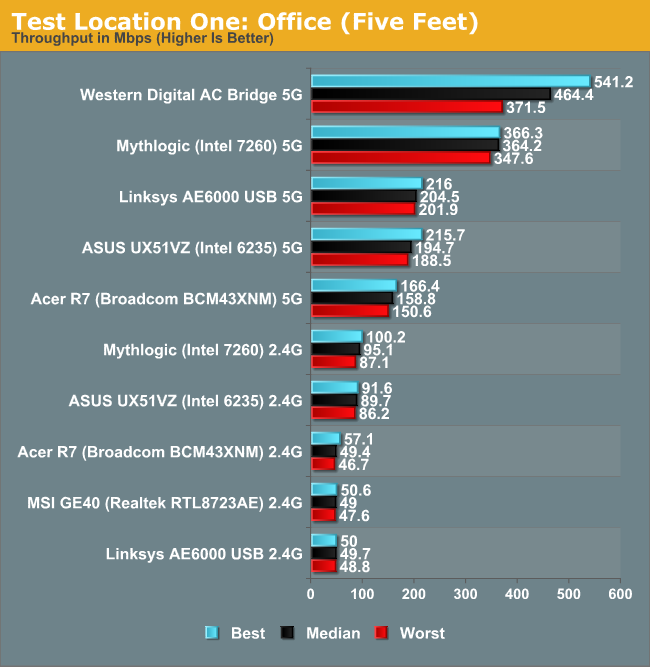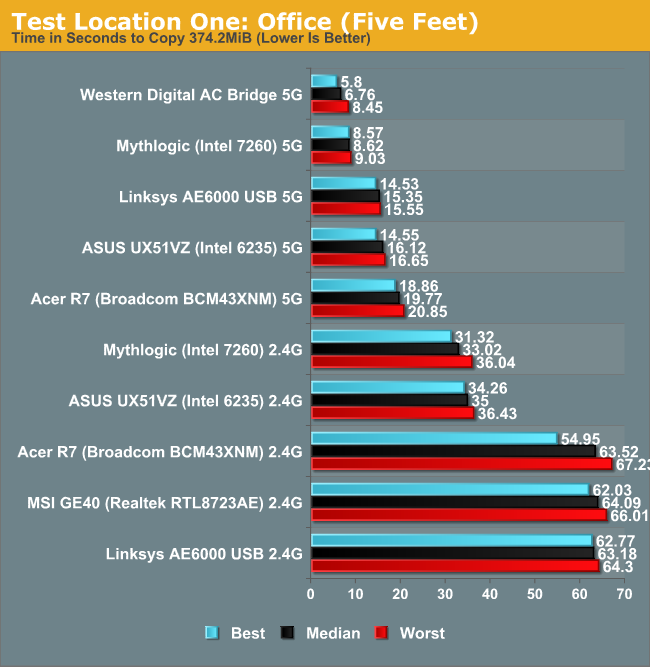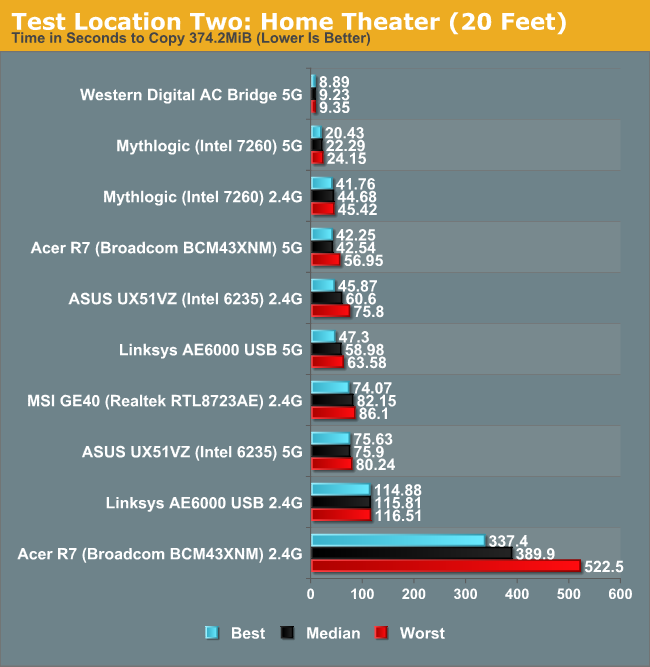The Joys of 802.11ac WiFi
by Jarred Walton on July 8, 2013 8:15 PM ESTA Quick Test of Real-World Wireless Performance
For testing, I grabbed a bunch of the hardware I had around and gathered one set of numbers: average throughput copying a single large file from my desktop with a wired Gigabit Ethernet connection to a laptop. I’m using Western Digital’s MyNet AC1300 router as the wireless router. The AC1300 is running firmware v1.03.09, and it's a product that has now been around for eight or so months. It supports up to 450Mbps (3x3:3 MIMO) on 802.11n connections and up to 1300Mbps on 5GHz 11ac connections. (Unfortunately, I didn't ever seem to connect with more than two 11ac streams with my current hardware, including Western Digital's AC Bridge.) We’re still not at Gigabit Ethernet speeds in most cases, but with nearly triple the throughput of the fastest 11n wireless it’s definitely getting closer.
For the adapters, I tested both single- and dual-band offerings. On the 802.11ac side, I used an 11ac bridge (the Western Digital My Net AC Bridge), a USB 11ac adapter (Linksys AE6000), and a Clevo P157SM notebook from Mythlogic (Pollux 1613) equipped with Intel’s latest Wireless-AC 7260 adapter. I should take a minute to note that one of the great things about going with a boutique laptop vendor like Mythlogic is the ability to customize not just the storage and CPU, but the WiFi adapter as well. Then I tossed in three other laptops, two of which I’m working on reviewing along with a previously reviewed laptop. The ASUS UX51VZ uses Intel’s common Wireless-N 6235 adapter (dual-band 2x2:2 MIMO with Bluetooth 4.0), Acer’s Aspire R7-571-6468 “oversized hybrid” uses a Broadcom BCM43XNM chipset (based on the hardware ID, it appears to be the BCM943228HM4L, or at least something similar—it’s also dual-band 2x2:2 MIMO with Bluetooth 4.0 support), and the MSI GE40 is the lone 2.4GHz single-band 150Mbps offering sporting a Realtek RTL8723AE chipset. All of the adapters were tested in both 2.4GHz and 5GHz modes (where applicable).
And with that said, here are the results from two test locations. Location one is with the target device in the same room as the router (my office), about five feet away. The second location is downstairs at the home theater area (my “second office”), about 20 feet away with one wall and one floor in between. The results show minimum, median, and maximum throughput of five test runs, with the caveat that I made sure there were no outliers—sometimes Windows or WiFi will have a really slow run or two.


Not surprisingly, the AC Bridge posts the best performance of all the solutions. With three spatial streams, I was hoping to get a lot closer to 800-900Mbps of throughput, but most of the time it appears to have run at closer to two streams. Performance isn't all that different from the Mythlogic laptop with Intel’s 7260 AC adapter at the short range location, but it’s over twice the speed at the second test location. What’s even worse is how poorly many of the solutions end up performing at the second test location.
I’m not surprised to see the Mythlogic notebook post excellent throughput over 5GHz 802.11ac, but it ends up being the third fastest solution even when falling back to 2.4GHz 802.11n at the second location! I could live with throughput of 50+ Mbps throughout my home, but pulling over 300Mbps from the downstairs HTPC to my other networked PCs over wireless is simply awesome…as long as the wireless signal doesn’t get dropped.
I haven’t actually had that happen with the Western Digital AC1300 (yet), but over the past seven or so years of testing notebooks and laptops for AnandTech, dropped wireless connections are a far too common occurrence in my experience. I’ve been through about ten wireless routers during that time, and even the best were never quite as stable/dependable as wired Ethernet. Some might go a couple weeks or even a month without needing a reboot (e.g. the Amped Wireless), while others might have WiFi "crash" every couple of days.
Throw in the lackluster WiFi adapters you find in most laptops (represented here by the Realtek RTL8723AE) and you can hopefully understand why having Gigabit Ethernet in notebooks still matters to a lot of people. I've got a second set of graphs that shows the same data as above, only in seconds required rather than Mbps:


Our current mobile test suite at present weighs in at a hefty 121GiB; over Gigabit Ethernet it takes about 20 minutes to copy everything over. Now imagine a laptop like the MSI GE40, except without the Ethernet port, and I’d be looking at nearly six hours just to copy the testing files over WiFi. (Thank goodness for USB 3.0 external SSD adapters!) But perhaps you never bother with copying large amounts of files over your local network, so slower WiFi speeds aren’t such an issue, right? My Comcast Internet now tops out with downstream speeds of up to 40Mbps and upstream rates of 12Mbps; when I’m not in my office, that means some of the adapters/laptops out there are likely going to bottleneck my Internet speed. It’s not the end of the world when you can only get 25Mbps, but there are certainly times when you’ll notice the difference—particularly if you have multiple PCs accessing the net concurrently.
One final item to discuss is that the adapters aren’t the whole story. You can see in the charts above that just because something supports two spatial streams on WiFi doesn’t inherently mean better performance than single stream adapters. The tiny USB WiFi adapter only manages average performance on a 5GHz connection from a couple rooms away from the router, and on a 2.4GHz connection it ends up being the slowest option outside of the Acer R7 2.4GHz result. Better antennas matter, and in the case of the Acer R7, the tuning of the antenna is likely another major factor.
The R7 actually fails to detect my 2.4GHz network from 50 feet away, yet it still manages to connect to the 5GHz network, and the R7 isn’t alone in such funky behavior. I’ve had laptops where the WiFi adapter powers off when the system has been running more than about 48 hours straight (even if the WiFi wasn’t doing anything), and the only way to get it back is to turn the adapter off and then turn it back on. And if laptops can sometimes have flaky WiFi implementations, many of the tablets out there are worse—range on two of my Android tablets is probably 50 feet at best before I have problems, so even my driveway is “too far” to get WiFi coverage.










139 Comments
View All Comments
HammerStrike - Tuesday, July 9, 2013 - link
Can anyone confirm if legacy standards (n/g/b/a) can be connected to a 801.11ac router, and still have it connect at ac speeds to ac native devices? I know that (at least with my current n class wifi router) if I connect a g class device the whole network goes down to g level speeds for all connected devices. Presumably with both 2.4ghz and 5ghz radio's the 2.4ghz can service legacy devices, while the 5ghz would be dedicated to ac devices. Is that correct, or and I misunderstanding that? Also, if I am correct, is that part of the ac standard, or up each manufacture to implement?name99 - Tuesday, July 9, 2013 - link
(a) Yes, the intelligent thing would be to segregate legacy devices to 2.4 GHz. Always has been.(b) With 802.11n, the smart thing to do is put the device in Greenfield mode for the 5GHz band, which will will not allow connections from anything except n.
(c) With 802.11ac, for better or worse there is no greenfield mode (maybe because pretty much no-one ever used it to run their networks optimally; Apple makes its use easy on Airport, but even there few people use it; apart from Apple no-one seems to even know it exists. You could maybe implement a greenfield mode equivalent in the router, just not allowing anyone not using ac to connect, perhaps by only broadcasting the SSID in 802.11ac format, but I don't know if that's within spec, or if anyone is doing it.)
This makes it even more imperative to get slow devices onto 2.4GHz, otherwise all your time is going to be used up by them slowly dribbling out their bits.
Gabik123 - Tuesday, July 9, 2013 - link
Can't wait for my almond+...hrrmph - Tuesday, July 9, 2013 - link
Good job putting the notebook computer manufacturers on notice that the performance of their wireless implementations are going to be measured (and how well they do counts a lot towards customer, and reviewer, satisfaction).They definitely need to get it right - especially on the expensive computers.
With form factors shrinking, the day when there isn't room for a LAN port is fast approaching, even for high-end machines.
-
wrong - Tuesday, July 9, 2013 - link
Thanks for the roundup. It's good to see data on this underserved topic.The big question for me is still "wireless or copper?", though, so I found myself wanting two things:
* Stats for just running a patch cable to the test locations
* More information about those outliers. It's a llittle disconcerting to see pauses and disconnects pruned from the data when they are actually the biggest influence on the quality of your experience.
JarredWalton - Tuesday, July 9, 2013 - link
The pauses are usually on the first run -- sometimes Windows still hasn't figured out where the other PC is on the network when I switch from 2.4 to 5GHz, or wired to wireless. It's maddening, but there are many times when I power up a laptop, open the path to my main PC in Explorer (\Nehalem if you're curious -- yup, my work system is still running a Bloomfield CPU!), and then... wait, get told the system isn't online, ping the IP address and get a response, try again, etc. and then about five minutes later Windows finally figures out where \Nehalem is "hiding". Grrr.... Mind you, this is with all the Windows Firewall stuff disabled as well.Wintek - Tuesday, July 9, 2013 - link
JarredThanks for the review. I did want to share that the only things that matter to me are reliability and range. The definition of a positive experience for me is when my wife wants to use the facebook app on her iphone 5, and it works. I have a 15/5 Mbps internet connection, which means that the speeds of nearly every test case presented would result in the same experience for my wife - what I really want to know is if the device is going to require constant rebooting and if it's going to work out on the deck, which is ~75 feet away through 3 walls. I didn't even set up the 5GHz SSID in her phone because it can't even reach past the same room as the access point. As far as speed tests go, the test that would be useful to me is reporting the number of feet when the connection drops below a 15Mbps reliable transfer speed. I purchased a Western Digital My Net N900 router because of the 7 ethernet ports and reported speed to hard drives attached to the USB port. What a bad choice, none of the online reviews reported the failures (should have listened to the Newegg user reviews) of this device for what I am guessing is overheating. Initially I was very pleased with the device with 5 of the ethernet ports used and reasonable wireless 2.4GHz range. But the first two each died after ~3weeks. I then bought a Netgear switch and just used the router as an access point. So far the third WD router is still working, but I had to reset it last night because of slow/flaky connectivity. It's this kind of experience that I would love your help in avoiding!
andrewaggb - Thursday, July 11, 2013 - link
Totally with you. Reliability and range trump speed.whyso - Tuesday, July 9, 2013 - link
Honestly one of the few things I honestly couldn't care less about on my 5mbps internet connection. No company offers faster internet in my location though the population demand is there and I don't expect faster than 20mbps in the next five years.designerfx - Wednesday, July 10, 2013 - link
maybe you should test this with the Asus RT-AC66U? I imagine the results would be profoundly different, based on smallnetbuilder's test results.http://www.smallnetbuilder.com/wireless/wireless-r...